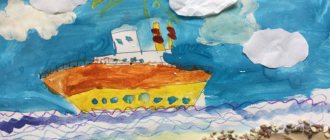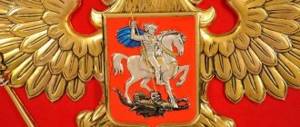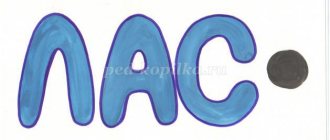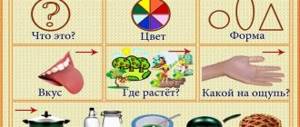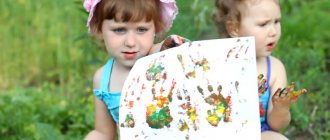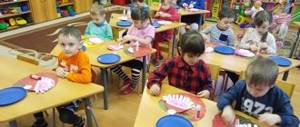Lesson summary for the preparatory group: “State symbols of Russia.”
Notes on nodes in the preparatory group.
(cognitive development and modeling) Prepared by teacher Streltsova O.E.
MBDOU d/s No. 68 “Firefly” Tambov
Topic: “
State symbols of Russia”
Program content:
-
education of patriotism, respect for symbols (flag, coat of arms, anthem);
— developing interest in the history and culture of the native country; — development of cognitive interest, expansion of horizons in the field of state symbols; — develop fine motor skills, — develop the skill of carefully applying a layer of plasticine on cardboard — fostering love for the Motherland. Methodical techniques:
Examination of illustrations, pictures. Solving a crossword puzzle, listening to tape recordings, playing “Gather at the Banner,” making a decorative plate “Russian Flag,” reading poetry. Equipment:
Coins, passport, images of ancient banners, documents with official seals, images of the modern flag, coat of arms, audio recording of the Russian anthem, images of flags of different countries, map of Russia, crossword puzzle, plasticine for making a decorative plate, 10x15 cm cardboard, marker, audio cassette with recording instrumental music, tape recorder.
Dictionary:
Symbols, coat of arms, flag, anthem, banner, Motherland, capital, pommel, pole.
Preliminary work:
Learning poetry, examining the coat of arms, the flag of Russia, talking about state symbols.
Progress of the lesson:
Children enter the hall (group) to the song “Smile” by V. Shainsky. - Children, today we have serious work ahead of us. What does the word “work” mean to you? — Study, learn something new, interesting. — Today in class you will learn a lot of interesting things. And in order not to miss anything, not to forget, you need to listen carefully, watch and remember everything, so that later you can tell your moms and dads about everything. Is everyone ready? Then go ahead and get new knowledge! — Now a secret mission awaits you. You need to solve the crossword puzzle to find out which country we will talk about. If we write the words in the boxes correctly, we will find out its name.
1. It flows, it flows - it won’t leak out, it runs, it runs - it won’t run out. (River) 2. What kind of tree do they say: it freezes, trembles in the wind. (Aspen) 3. A polite word, expresses gratitude. (Thank you) 4. A white blanket covered the whole earth. (Snow) 5. Gold coins fall from the branch. (Leaves) 6. A worker, a forest-nosed carpenter, lives in the forest. (Woodpecker) Children recite the poem “On the Map”: You won’t find the house in which you live on the map of the world. And you won’t even find your native street on that map. But we will always find our country on it - our common home. V. Stepanov The teacher invites the children to look at the map of Russia. He says: - This is Russia - the country where we were born and live. How can you say about our country, what is it like? Children select signs for the word “country”. (Beloved, dear, beautiful, huge, endless, rich, beautiful, powerful, cheerful, sad, etc.) - There are a lot of different countries in the world. Each has its own flag, a certain color. (Look at the flags of different countries). — Today we will get acquainted with the history of the flag of our country - Russia. (The teacher shows the children drawings depicting banners and tells) - Many centuries ago, instead of a flag, they used a pole (stick), tying tufts of grass, branches or a ponytail painted with bright paint to its top. It was called a banner. The main purpose was to gather and unite all the soldiers to defend their land, village or city if enemies suddenly attacked. Comes from the word “to pull towards oneself” - banner. - Let's repeat, what were the ancient flags called? - Banners. -What were they made of? - From grass, branches, sticks, feathers. —What were they needed for? - Unite people. — As time went on, banners began to be made from fabric. The fabric was attached to the shaft, and an iron pommel appeared above it. Most often the banners were red. They fluttered in the wind and gave the soldiers confidence. The flag is a distinctive sign of the country and signifies the unity of the state. — Let's look at the Russian flag. How many colors does it have? (Children look at the image of the flag and name its colors.) Then they recite the poem “Flag of Russia”: White is the birch tree, Blue is the color of the sky, Red stripe is the sunrise. V. Stepanov - Each color carries a certain meaning. White color - peace and purity. He says that our country loves peace and never attacks anyone. Blue is the color of the sky and signifies loyalty and truth. That is, the people love their country and will protect it from enemies at any time. Red color is fire and courage (courage), the color of strength. Game "Gather at the Banner". — Where can you see flags or flags? — On buildings, for example, on the Government House. On holidays, houses and streets are decorated. Flags can be seen on ships, planes, in the hands of soldiers and athletes. If there is a flag on a plane or ship, it will help you find out what country they are from. During large sporting competitions, for example, during the Olympic Games, it is possible to find out which countries athletes will be participating in these competitions. During the award ceremony, the flag of the winning country is raised high, high above the stadium. At this time, we feel proud of our athletes, of our Motherland. In addition to the flag, the distinctive sign of the country is the coat of arms. Let's look at the coat of arms of Russia. -What do you see in the center? - Orla. — Tell us about him, what is he like? - With two heads, with raised wings. - Why do you think the eagle is depicted? — The eagle on the coat of arms denotes strength, it means that the state is strong and invincible. - But why does the eagle have two heads? — Russia is a big country, the heads of the eagle look to the west and east, this means that the state is large, but united. People of different nationalities live in Russia - Russians, Tuvans, Yakuts, etc. In the center of the large coat of arms there is another one, this is the coat of arms of the main city of our country - Moscow. Because Moscow is the capital of Russia. — Where can you see the coat of arms? — It is placed on special border posts. Guests who come from other countries, seeing the coat of arms and flag, will be able to determine that they have arrived in Russia. Next, the teacher invites the children to come to the table and look at the coins. — What did you see on the coins? - Coat of arms. — The coat of arms is needed not only for money, it is necessary for seals, for important documents (they are considering). After looking and talking, the children recite the poem “Coat of Arms of Russia”: The majestic Russia has a double-headed eagle on its coat of arms, So that he can immediately look to the west and east. He is strong, wise and proud. He is Russia's free spirit. V. Stepanov - In addition to the flag and coat of arms, each country has its own anthem. The anthem is also a symbol, it is a solemn song. The anthem is performed during the most solemn occasions. During the performance, everyone must stand up, and the men take off their hats. (Children listen to a recording of an excerpt from the “National Anthem of Russia”). — In February, our country celebrates the holiday of all men, “Defender of the Fatherland Day,” so we will make a decorative plate with the image of the Russian flag as a gift for dads and grandfathers. Children make an image of the Russian flag from plasticine. As the work progresses, the teacher reminds the children about the location of the stripes on the flag and their color. (The work is done on cardboard measuring 10x15 cm, children sequentially apply plasticine onto the cardboard, carefully distributing it with their fingers in the form of stripes of the Russian flag: white, blue, red plasticine)
